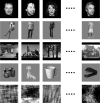Intra- and interhemispheric connectivity between face-selective regions in the human brain
- PMID: 22972952
- PMCID: PMC3544867
- DOI: 10.1152/jn.01171.2011
Intra- and interhemispheric connectivity between face-selective regions in the human brain
Abstract
Neuroimaging studies have revealed a number of regions in the human brain that respond to faces. However, the way these regions interact is a matter of current debate. The aim of this study was to use functional MRI to define face-selective regions in the human brain and then determine how these regions interact in a large population of subjects (n = 72). We found consistent face selectivity in the core face regions of the occipital and temporal lobes: the fusiform face area (FFA), occipital face area (OFA), and superior temporal sulcus (STS). Face selectivity extended into the intraparietal sulcus (IPS), precuneus (PCu), superior colliculus (SC), amygdala (AMG), and inferior frontal gyrus (IFG). We found evidence for significant functional connectivity between the core face-selective regions, particularly between the OFA and FFA. However, we found that the covariation in activity between corresponding face regions in different hemispheres (e.g., right and left FFA) was higher than between different face regions in the same hemisphere (e.g., right OFA and right FFA). Although functional connectivity was evident between regions in the core and extended network, there were significant differences in the magnitude of the connectivity between regions. Activity in the OFA and FFA were most correlated with the IPS, PCu, and SC. In contrast, activity in the STS was most correlated with the AMG and IFG. Correlations between the extended regions suggest strong functional connectivity between the IPS, PCu, and SC. In contrast, the IFG was only correlated with the AMG. This study reveals that interhemispheric as well as intrahemispheric connections play an important role in face perception.
Figures







Similar articles
-
Consecutive TMS-fMRI reveals remote effects of neural noise to the "occipital face area".Brain Res. 2016 Nov 1;1650:134-141. doi: 10.1016/j.brainres.2016.08.043. Epub 2016 Aug 30. Brain Res. 2016. PMID: 27590719
-
Mechanisms of hemispheric lateralization: Asymmetric interhemispheric recruitment in the face perception network.Neuroimage. 2016 Jan 1;124(Pt A):977-988. doi: 10.1016/j.neuroimage.2015.09.055. Epub 2015 Oct 9. Neuroimage. 2016. PMID: 26439515
-
Resting-state fMRI reveals functional connectivity between face-selective perirhinal cortex and the fusiform face area related to face inversion.Neuroimage. 2014 May 15;92:349-55. doi: 10.1016/j.neuroimage.2014.02.005. Epub 2014 Feb 12. Neuroimage. 2014. PMID: 24531049
-
Fusing concurrent EEG-fMRI with dynamic causal modeling: application to effective connectivity during face perception.Neuroimage. 2014 Nov 15;102 Pt 1:60-70. doi: 10.1016/j.neuroimage.2013.06.083. Epub 2013 Jul 9. Neuroimage. 2014. PMID: 23850464 Review.
-
The neuropsychology of face perception: beyond simple dissociations and functional selectivity.Philos Trans R Soc Lond B Biol Sci. 2011 Jun 12;366(1571):1726-38. doi: 10.1098/rstb.2010.0349. Philos Trans R Soc Lond B Biol Sci. 2011. PMID: 21536556 Free PMC article. Review.
Cited by
-
Sex-differences of face coding: evidence from larger right hemispheric M170 in men and dipole source modelling.PLoS One. 2013 Jul 9;8(7):e69107. doi: 10.1371/journal.pone.0069107. Print 2013. PLoS One. 2013. PMID: 23874881 Free PMC article.
-
Integrating predictive frameworks and cognitive models of face perception.Psychon Bull Rev. 2018 Dec;25(6):2016-2023. doi: 10.3758/s13423-018-1433-x. Psychon Bull Rev. 2018. PMID: 29423572 Review.
-
Domain Specificity of Oculomotor Learning after Changes in Sensory Processing.J Neurosci. 2017 Nov 22;37(47):11469-11484. doi: 10.1523/JNEUROSCI.1208-17.2017. Epub 2017 Oct 20. J Neurosci. 2017. PMID: 29054879 Free PMC article.
-
Joint estimation of source dynamics and interactions from MEG data.Netw Neurosci. 2025 Jul 17;9(3):842-868. doi: 10.1162/netn_a_00453. eCollection 2025. Netw Neurosci. 2025. PMID: 40703192 Free PMC article.
-
Neural responses to expression and gaze in the posterior superior temporal sulcus interact with facial identity.Cereb Cortex. 2014 Mar;24(3):737-44. doi: 10.1093/cercor/bhs360. Epub 2012 Nov 21. Cereb Cortex. 2014. PMID: 23172771 Free PMC article.
References
-
- Andrews TJ, Clarke A, Pell P, Hartley T. Selectivity for low-level features of objects in the human ventral stream. Neuroimage 49: 703–711, 2010a - PubMed
-
- Andrews TJ, Ewbank MP. Distinct representations for facial identity and changeable aspects of faces in the human temporal lobe. Neuroimage 23: 905–913, 2004 - PubMed
-
- Biswal B, Yetkin FZ, Haughton VM, Hyde JS. Functional connectivity in the motor cortex of resting human brain using echo-planar MRI. Magn Reson Med 34: 537–541, 1995 - PubMed
Publication types
MeSH terms
Grants and funding
LinkOut - more resources
Full Text Sources
Other Literature Sources

